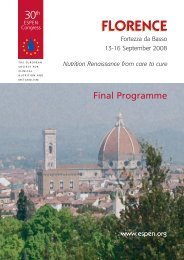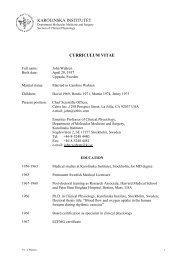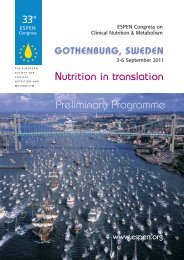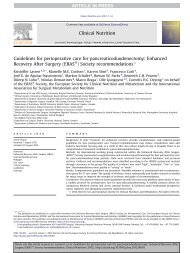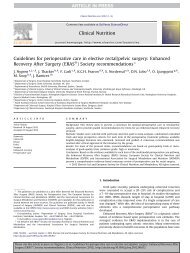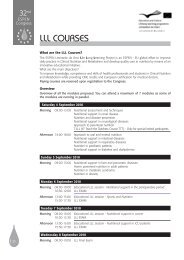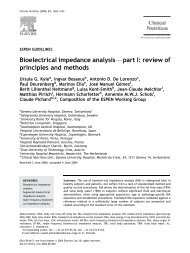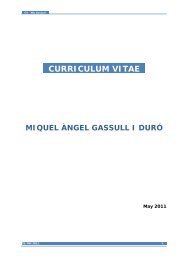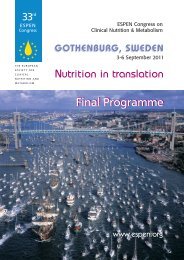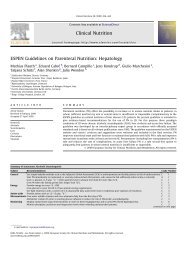Download Final Programme - espen
Download Final Programme - espen
Download Final Programme - espen
Create successful ePaper yourself
Turn your PDF publications into a flip-book with our unique Google optimized e-Paper software.
31 st<br />
ESPEN<br />
Congress<br />
ABOUT ESPEN<br />
ESPEN, The European Society for Clinical Nutrition and Metabolism, is a multiprofessional society<br />
dedicated to all issues relevant to the field of Clinical Nutrition and Metabolism and promotes:<br />
– Basic and clinical research<br />
– Basic and advanced education<br />
– Organization of consensus statements about clinical care and care quality control<br />
– Networking for nutrition-related professionals<br />
The aims of ESPEN are to encourage the rapid diffusion of knowledge and its application in the field<br />
of Clinical Nutrition and Metabolism.<br />
ESPEN sponsors two journals, Clinical Nutrition and e-SPEN Journal, for which it assumes editorial, as<br />
distinct from publishing, responsibility.<br />
ESPEN promotes experimental and clinical research, fosters high ethical standards of practice and<br />
investigation, and promotes contact between investigators and clinicians in related fields.<br />
4<br />
HISTORY<br />
ESPEN was formally established in 1980, but its foundations were laid in an informal International<br />
meeting in Stockholm in 1979, which has commonly come to be regarded as the first ESPEN meeting.<br />
Here, it was decided to set up a multidisciplinary Society devoted to the study of metabolic problems<br />
associated with acute diseases together with their nutritional implications and management and, to<br />
publish a journal on Clinical Nutrition.<br />
It was not the first Society associated to clinical nutrition. ISPN, the International Society of Parenteral<br />
Nutrition, had been founded in 1966 to discuss the scientific work arising from the rapid development<br />
in Europe of parenteral nutrition in the late 50s and early 60s. ISPN, which counted both European<br />
and American members, held its meetings during the ICN Congresses in various parts of the world.<br />
The spreading interest in parenteral nutrition in the US in the 60s eventually led to the establishment<br />
of the American Society of Parenteral and Enteral Nutrition (ASPEN) in 1977.<br />
ISPN had to redefine its role to better target the needs of those involved in clinical nutrition in Europe<br />
and it was decided that there was a need for a scientifically-orientated organisation providing a<br />
common ground for European scientists from many disciplines involved in nutritional support. A first<br />
informal meeting was therefore held in Stockholm in 1979 and invitations were sent to key individuals<br />
in the various European countries with an interest in clinical nutrition. Financial support was granted by<br />
a number of European industrial firms.<br />
The following year a meeting of 800 participants was held in Newcastle where ESPEN was officially<br />
founded and its constitution agreed: the Society’s officers would be composed of a President, a<br />
Secretary, a Treasurer and two Auditors; there would also be a Council, consisting of one key member<br />
from each participating country who would elect members to the Executive Committee.<br />
The success of the following meetings in terms of number of participants (Maastricht (1981) with<br />
1300 participants, Vienna (1982) with 1800 participants) and industrial exhibitions showed that<br />
ESPEN was stimulating considerable interest both in the scientific and industrial world. Its growing<br />
responsibilities led to the establishment of a Scientific Committee that was to assist in giving scientific<br />
direction to the meetings and lay down guidelines to maintain high standards for abstract selection,<br />
evaluate and select abstracts and appoint reviewers for each topic and; an Educational Committee,<br />
whose task was to coordinate the educational aspects of the Society, and an Industry Liaison Group to<br />
develop links between ESPEN and the industry.<br />
The Society’s rapid expansion in the following years called for further adjustments in terms of ESPEN’s<br />
organisation and policy. A President in charge of organising the following Congress would serve on the<br />
Executive Committee for one year, while a Committee Chairman would serve for four years to ensure<br />
continuity to ESPEN’s policy. Research was promoted by offering a gradually increasing number of<br />
travel fellowships and ESPEN Research Fellowships. The first postgraduate course, run by the<br />
Educational Committee, was established in Brussels in 1984. Steps were taken to widen the<br />
participation of the members in running the affairs of the Society, and smaller additional meetings were<br />
held in Budapest and Tel Aviv to facilitate the spread of knowledge and provide scientific interchange<br />
in wider geographical areas. The first website was created in 1999 to further disseminate ESPEN’s<br />
activities (www.<strong>espen</strong>.org). In time, the Scientific and Educational Committees were enlarged to<br />
include representatives of all disciplines.



